Explore Abu Dhabi - United Arab Emirates (UAE) Travel, Asia
Abu Dhabi, the glittering capital of the United Arab Emirates (UAE), is a city of contrasts. Known for its modern skyline, rich cultural heritage, and world-class hospitality, Abu Dhabi offers travelers a chance to experience the best of both worlds—traditional Arabian charm and contemporary luxury. Whether you're exploring grand mosques, relaxing on pristine beaches, or indulging in luxury shopping, Abu Dhabi has something for everyone. As a top destination for international visitors, it’s an excellent place for adventurers, culture seekers, and families alike.
Population: Approximately 3.7 million in 2023.
Economy: Abu Dhabi's economy is driven by oil exports, contributing significantly to the UAE’s wealth. It also boasts a growing non-oil sector, including finance, tourism, real estate, and renewable energy.
Landmarks: Famous for the Sheikh Zayed Grand Mosque, Louvre Abu Dhabi, and the Qasr Al Hosn.
United Arab Emirates
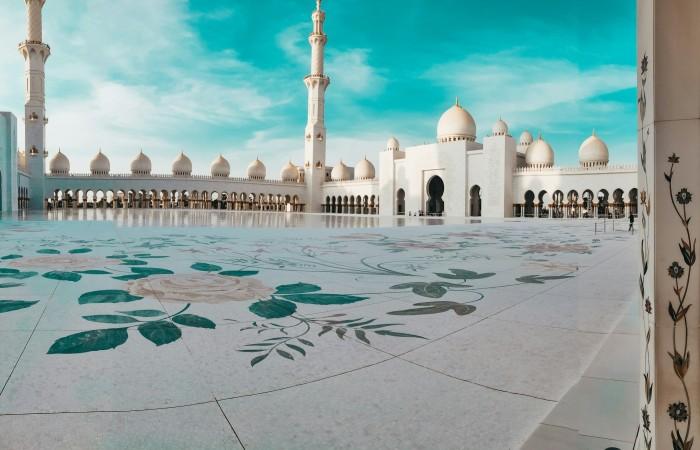
Overview of Abu Dhabi
History & Cultural Influence
Abu Dhabi’s transformation from a small fishing village to a global metropolis is a story of vision and resilience. Its name, which translates to "Father of the Gazelle," reflects its historical connection to the natural desert environment. In the late 20th century, with the discovery of oil, the city saw rapid modernization. Despite its modern evolution, Abu Dhabi maintains strong ties to its heritage. You’ll find influences of Islamic culture, Bedouin traditions, and Arabian hospitality in every corner of the city. For visitors, it’s a chance to immerse themselves in the stories of the past while appreciating the city’s forward-thinking development.
Interaction with the Locals
Abu Dhabi is home to over 3.7 million people, with the majority being expatriates from around the world. Emirati citizens make up roughly 20% of the population, and they are known for their deep cultural roots, strong sense of community, and warm hospitality. The local population is proud of their heritage, with Bedouin traditions and Islamic values influencing daily life. Despite the city's rapid modernization, Emiratis continue to uphold their customs while embracing international diversity, making Abu Dhabi a welcoming and multicultural destination.
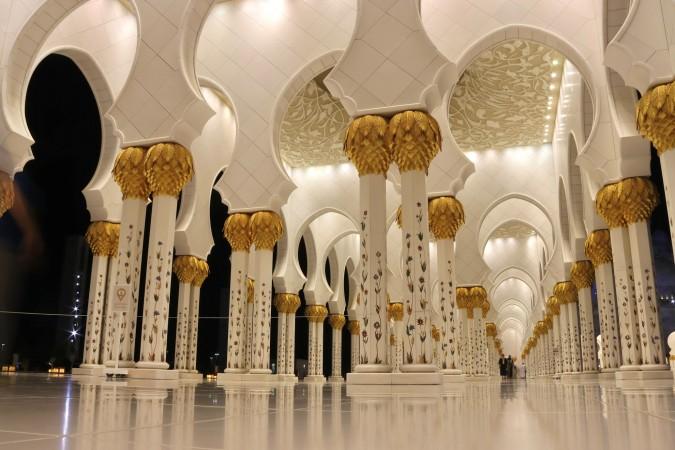
Sheikh Zayed Grand Mosque hall - © Hongbin
Top Attractions in Abu Dhabi
Abu Dhabi is packed with must-see attractions that reflect both its modern ambitions and cultural roots. From architectural wonders to entertainment-packed destinations, Abu Dhabi offers a wide range of experiences for all types of travelers.
- Sheikh Zayed Grand Mosque: This iconic landmark is not only one of the largest mosques in the world but also a masterpiece of Islamic architecture. Featuring over 80 domes, marble-clad courtyards, and crystal chandeliers, it offers visitors a serene space to learn about Islamic culture and admire its beauty.
- Louvre Abu Dhabi: Located on Saadiyat Island, Louvre Abu Dhabi is a cultural gem that unites art from different civilizations. The museum’s unique design—featuring a dome that lets in dappled sunlight—blends contemporary architecture with a deep respect for history.
- Ferrari World: If you’re looking for adrenaline-pumping fun, Ferrari World is a must-visit tourist spot. Home to the world’s fastest roller coaster, this theme park offers an exciting mix of attractions for thrill-seekers and families alike.
- Yas Island: Yas Island is a world-class entertainment hub. Visitors can enjoy a range of activities here, from water slides at Yas Waterworld to Formula 1 racing at Yas Marina Circuit. It’s the perfect place for families and adventure lovers.
- Qasr Al Hosn: One of the oldest stone buildings in Abu Dhabi, Qasr Al Hosn is a symbol of the city’s history. Today, it serves as a museum that tells the story of Abu Dhabi’s transformation, making it a great stop for history buffs.
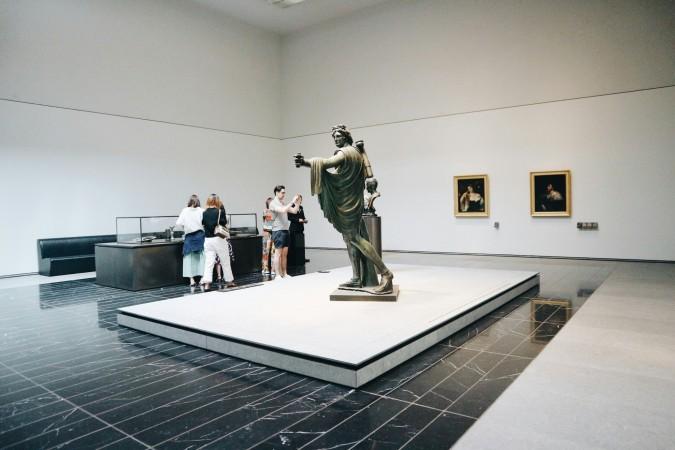
Louvre Abu Dhabi - © Zalfa Imani
Must-Try Dishes in Abu Dhabi
Abu Dhabi’s cuisine is a delightful blend of traditional Emirati cuisine, Middle Eastern flavors, and international influences. The city’s culinary offerings through its local dishes reflect the diverse population and rich heritage, making it a paradise for food lovers.
- Shawarma: A popular street food across the UAE, shawarma consists of thinly sliced meat (usually chicken or lamb) seasoned with aromatic spices, wrapped in flatbread, and served with garlic sauce, pickles, and vegetables. It’s an affordable and delicious snack you can find everywhere.
- Machboos: This traditional Emirati cuisine consists of rice, meat (typically lamb or chicken), and a spice blend including saffron and cardamom. Often compared to biryani, Machboos is a fragrant and hearty meal that gives you a taste of authentic local flavors.
- Luqaimat: Luqaimat are sweet dumplings, crispy on the outside and soft on the inside, typically served with a drizzle of date syrup or honey. These are particularly popular during Ramadan but can be enjoyed year-round.
- Mandi: Mandi is a traditional dish with roots in Yemen but is now widely loved in Abu Dhabi. It consists of rice and slow-cooked meat (usually lamb or chicken), seasoned with a rich blend of spices and often cooked in a tandoor oven.
- Arabic Coffee: No visit to Abu Dhabi is complete without trying dates and Arabic coffee (Gahwa). Dates, often stuffed with nuts or served plain, are a staple of Emirati hospitality. Gahwa, brewed with cardamom and saffron, is served in small cups and is a symbol of warmth and generosity.

Machboos - © Maggi Arabia
Festivals & Local Celebrations
Abu Dhabi is home to a vibrant calendar of festivals and celebrations that offer visitors an immersive cultural experience. These festivals and celebrations not only offer entertainment but also provide an opportunity to experience the city’s cultural depth and traditions.
Abu Dhabi Film Festival
This prestigious event attracts filmmakers, celebrities, and movie buffs from around the world. The festival features a varied selection of films, including world and Arab cinema, and provides an excellent platform for cultural interaction and creativity.
UAE National Day (December 2)
National Day is one of the most significant celebrations in Abu Dhabi. The city comes alive with parades, fireworks, and cultural events that celebrate Emirati pride and unity. It’s a joyful time for both locals and visitors to participate in the celebrations.
Ramadan & Eid Al-Fitr
Ramadan, the holy month of fasting, holds special significance for the people of Abu Dhabi. The city slows down during the day, but after sunset, you’ll find vibrant Iftar gatherings with families and friends breaking their fast together. The festival of Eid Al-Fitr, which marks the end of Ramadan, is celebrated with feasts, prayers, and charitable giving.
Al Dhafra Festival
Held in the desert region of Al Dhafra, this festival is a tribute to Bedouin culture and heritage. It features camel racing, falconry competitions, and traditional crafts, offering visitors a chance to experience the authentic side of Emirati life.
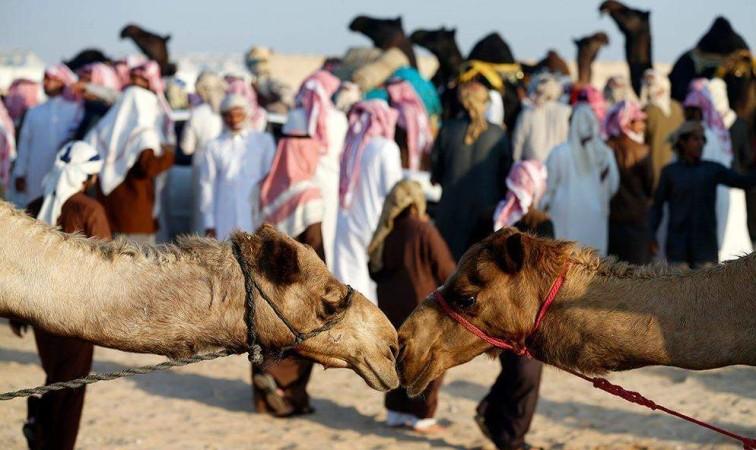
Al Dhafra Festival - © Verdict
What to Do in Abu Dhabi
- Desert Safari & Dune Bashing: A desert safari allows you to experience dune bashing in a 4x4 vehicle, camel rides, sandboarding, and traditional Bedouin camp experiences. It’s a must-do for adrenaline junkies and those wanting to experience the desert’s natural beauty.
- Mangrove Kayaking: Escape the bustling city and paddle through Abu Dhabi’s serene mangrove forests. Kayaking in the mangroves offers a peaceful encounter with nature, where you can spot local wildlife such as flamingos and herons while learning about the region’s ecosystem.
- Pearl Diving Experience: Visitors can experience UAE heritage firsthand by joining a pearl diving tour, where you’ll learn about the ancient methods used to harvest pearls and even try your hand at finding your own.
- Golf Tours in Abu Dhabi: Abu Dhabi is home to world-class golf courses such as Abu Dhabi Golf Club and c. These stunning courses offer not only a great golfing experience but also beautiful views of the surrounding landscape, from desert dunes to oceanfront vistas.
Shopping in Abu Dhabi
- Galleria Mall: For a high-end shopping experience, The Galleria on Al Maryah Island is a must-visit. It features luxury brands like Louis Vuitton, Chanel, and Gucci, as well as fine dining restaurants and a picturesque waterfront setting.
- Souk Qaryat Al Beri: If you’re looking for a traditional shopping experience, head to Souk Qaryat Al Beri. This charming marketplace offers a variety of handmade crafts, spices, textiles, and jewelry. The souk’s unique architecture and waterfront views make it a beautiful place to explore.
- Gold Souk: The Gold Souk in Abu Dhabi is a treasure trove for those looking for exquisite gold jewelry. Whether you’re looking for a simple bracelet or an elaborate necklace, you’ll find an array of options at competitive prices.
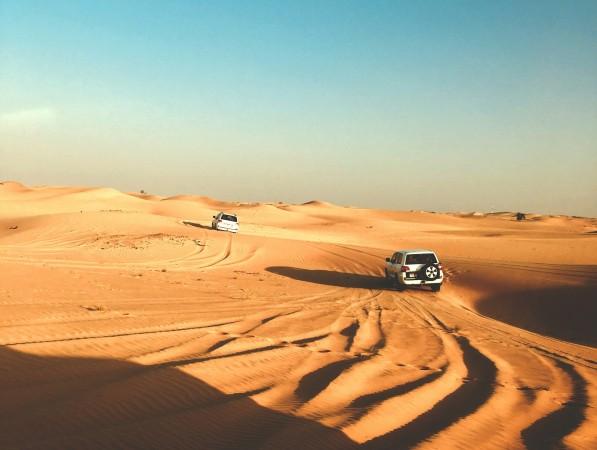
Desert Safari in Abu Dhabi - © Jakub David
Weather in Abu Dhabi: Best Time to Visit
Spring in Abu Dhabi
Spring brings slightly warmer temperatures, ranging from 25°C to 35°C (77°F to 95°F). While it’s still comfortable for outdoor activities in April, May can start feeling hot, particularly during midday. This is a good time to explore indoor attractions like museums and shopping malls during the hotter hours while enjoying outdoor experiences in the morning or evening.
Summer in Abu Dhabi
Summers in Abu Dhabi are extremely hot, with temperatures often soaring above 40°C (104°F) and humidity levels rising. The intense heat makes outdoor activities challenging, so this is the time to enjoy the city’s indoor attractions, such as luxury shopping malls, spas, and cultural venues like the Louvre Abu Dhabi. Many hotels and resorts offer great deals during the summer, making it a good time for those looking to experience luxury at a more affordable price.
Autumn in Abu Dhabi
Autumn marks the transition from the scorching summer heat to cooler, more tolerable temperatures. During October, the weather becomes more comfortable, with temperatures ranging between 25°C and 35°C (77°F to 95°F). This period is ideal for both indoor and outdoor activities, with beaches and outdoor attractions starting to regain their popularity.
Winter in Abu Dhabi
Winter is the most popular time to visit Abu Dhabi, as the weather is mild and pleasant. Temperatures during this season range from 15°C to 25°C (59°F to 77°F), making it ideal for outdoor activities such as desert safaris, beach outings, and sightseeing. You can comfortably explore the city’s top attractions without worrying about the heat. Occasional rainfall may occur, but it’s typically light and short-lived.
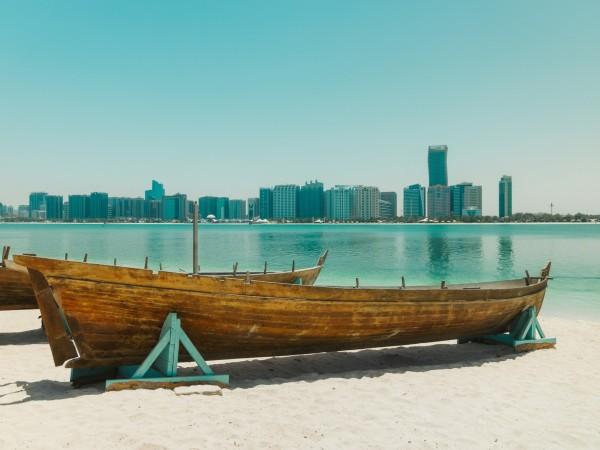
A clear day for a boat tour around Abu Dhabi - © Damian Kamp
Essential Travel Information
Getting Around Abu Dhabi
- Taxis: Taxis are the most common and convenient way to travel around Abu Dhabi. They are readily available, metered, and affordable. You can hail a taxi on the street, book one through a phone app, or find them at major landmarks, shopping malls, and hotels.
- Public Buses: The Abu Dhabi Department of Transport operates a well-organized bus system that covers most parts of the city. Buses are a cost-effective way to get around, with air-conditioned vehicles and regular schedules.
- Car Rentals: For travelers who prefer flexibility, renting a car is an excellent option. Driving in Abu Dhabi is relatively straightforward, with modern roads and clear signage.
- Abra Rides: For a more traditional experience, you can hop on an abra, a small wooden boat that ferries passengers across the water. Abras offer a scenic way to enjoy the city’s waterfront areas and are particularly popular in areas like Souk Qaryat Al Beri.
Atm & Banking Services
Abu Dhabi offers convenient and widespread access to ATMs and banking services, ensuring that visitors can easily manage their finances while traveling. ATMs are located in key areas such as malls, hotels, and public spaces, and most accept international credit and debit cards. With many ATMs operating 24/7, managing cash and transactions is hassle-free throughout the city.
Where to Stay in Abu Dhabi
- Luxury Hotels: These properties provide top-notch amenities, private beaches, fine dining, and opulent rooms with stunning views of the city or the Arabian Gulf. Guests can expect world-class service, spa treatments, and exclusive experiences that offer a truly lavish stay.
- Mid-Range Hotels: These hotels offer modern facilities, including pools, gyms, and on-site dining, while maintaining an affordable price. They are often located near popular attractions, making them ideal for travelers looking to explore the city without sacrificing comfort.
- Resort Stays: For those wanting a relaxing beach getaway, Abu Dhabi’s resorts offer serene settings along pristine coastlines. These resorts combine luxury and tranquility, providing private beaches, water sports, and spa services for a peaceful retreat.
Des articles pour vous

Voyage à Kampong Cham - Cambodge, Asie
Kampong Cham est une charmante ville riveraine située le long du fleuve Mékong. Connue pour son importance historique et ses attractions culturelles, Kampong Cham offre un mélange d'architecture coloniale, de temples anciens et de paysages pittoresques. Kampong Cham est reliée au district voisin de Tbong Khmum par le pont Kizuna, le premier pont au Cambodge à traverser le fleuve Mékong, en faisant un carrefour de transport crucial pour la région.
Population : Estimation de 80 000 habitants (en 2024)
Économie : Bien que n'étant pas encore une destination touristique majeure, Kampong Cham propose des sites culturels et historiques, tels que le temple Wat Nokor et le pont en bambou de Koh Pen, ainsi que des attractions naturelles comme des forêts et des chutes d'eau. Le gouvernement se concentre sur le développement du tourisme pour améliorer l'économie locale.
Points d'intérêt : Wat Nokor Bachey, Phnom Han Chey, Phnom Pros et Phnom Srey, pont en bambou de Koh Pen, Wat Joy T'maw, Preah Theat Teuk Chha, piste d'atterrissage abandonnée de l'US.

Explorez Nha Trang - Voyage au centre du Vietnam, Asie
Nichée le long de la magnifique côte du Vietnam, Nha Trang se distingue comme une destination de premier choix pour les voyageurs. Cette ville côtière, réputée pour ses superbes plages et sa vie marine foisonnante, s'adresse à tous. Nha Trang vous accueille à bras ouverts, que vous recherchiez des aventures, de la culture ou de la détente au bord de la mer. Ce guide vous fera découvrir les points forts de cet endroit magnifique, facilitant ainsi la planification de votre voyage de manière fluide et excitante.
Population : Environ 423 000 habitants en 2019.
Économie : L'un des principaux centres touristiques du Vietnam et la plus grande économie de la province de Khanh Hoa.
Sites emblématiques : Célèbre pour les tours Cham de Po Nagar, la cathédrale de Nha Trang et l'île Hon Mun.

Voyage à Sihanoukville - Cambodge, Asie
Sihanoukville, une ville côtière du sud-ouest du Cambodge, est la capitale de la province de Preah Sihanouk. Située sur une péninsule le long du golfe de Thaïlande, la ville est bien reliée à Phnom Penh par des autoroutes principales et dispose d'un aéroport international.
La ville abrite le seul port en eau profonde du Cambodge, jouant un rôle crucial dans la logistique et le commerce du pays. Les plages magnifiques de Sihanoukville, telles qu'Ochheuteal et Serendipity, attirent aussi bien les touristes nationaux qu'internationaux. Le développement économique a prospéré ces dernières années, en particulier grâce à la création de la Zone économique spéciale de Sihanoukville (SSEZ) et aux investissements chinois dans les casinos, l'immobilier et les stations balnéaires. La ville offre également des attractions naturelles telles que le parc national de Ream et plusieurs îles voisines, en faisant une destination variée pour les voyageurs d'affaires et de loisirs.
Population : La population de Sihanoukville était d'environ 160 000 habitants en 2024.
Économie : Sihanoukville, une ville côtière en pleine croissance au Cambodge, se distingue par son mélange dynamique de développement économique et de tourisme. La Zone économique spéciale de Sihanoukville (SSEZ) est devenue un pôle industriel majeur, abritant plus de 180 entreprises et créant des milliers d'emplois. Avec le seul port en eau profonde du Cambodge, la ville joue un rôle clé dans le commerce et la logistique du pays. Bien qu'elle se soit transformée d'une petite ville balnéaire tranquille en un centre urbain animé, Sihanoukville reste célèbre pour ses plages immaculées, attirant des touristes tout au long de l'année. Les investissements chinois importants ont alimenté la croissance des hôtels, des casinos et de l'immobilier, faisant de la ville un centre d'opportunités économiques et d'hospitalité.
Monuments : Plage d'Otres, Plage d'Ochheuteal, Plage de l'Indépendance, Parc national de Ream, Chute d'eau de Kbal Chhay, Monument des Lions d'Or, Wat Leu.

Explorez Kharkhorin - Voyage en Mongolie, Asie
Bienvenue à Kharkhorin, un trésor historique niché au cœur de la Mongolie. Ancienne capitale vibrante de l'Empire Mongol sous le légendaire Gengis Khan, Kharkhorin se dresse comme un témoignage de la riche culture et de l'histoire de la Mongolie. Cette ville antique possède une combinaison unique d'importance historique et de paysages époustouflants, en faisant une destination incontournable pour un voyage de rêve en Mongolie. En mettant le pied à Kharkhorin, vous ferez un saut dans le temps, à une époque de grands palais, de routes commerciales prospères et d'échanges culturels sans pareils. Que vous soyez intrigué par les ruines anciennes, désireux d'explorer les traditions locales ou simplement en quête d'une immersion dans la beauté naturelle de la Mongolie, Kharkhorin a quelque chose à offrir à chacun.
Population : Environ 1 000 habitants en 2020.
Économie : L'une des attractions touristiques les plus importantes de la Mongolie et l'ancienne capitale de l'Empire Mongol.
Monuments : Célèbre pour les Ruines de Kharkhorin, le Monastère d'Erdene Zuu, et la Vallée d'Orkhon, un site du patrimoine mondial de l'UNESCO.

Explore Luang Prabang - Laos Travel, Asia
Luang Prabang, nestled in northern Laos at the meeting point of the Mekong river and Nam Khan river, is a city celebrated for its rich cultural heritage and stunning natural beauty. Recognized as a UNESCO World Heritage Site in 1995, it boasts a unique blend of traditional Lao and French architecture that has been carefully preserved. Whether you're wandering through its ancient temples, admiring the local architecture, or soaking in the natural beauty of waterfalls and rivers, Luang Prabang offers something for everyone.
Population: Approximately 470,000 in 2020.
Economy: Luang Prabang's economy thrives on tourism, with its UNESCO status drawing visitors to its temples, natural wonders, and cultural experiences. Local crafts, hospitality, and small businesses also play vital roles, supporting the town's sustainable growth. Local crafts, hospitality, and small businesses also play vital roles, supporting the town's sustainable growth.
Landmarks: Famous for the Wat Xieng Thong, Royal Palace Museum (also known as Haw Kham), and Mount Phousi (Phou Si Hill).Luang Prabang, nestled in northern Laos at the meeting point of the Mekong river and Nam Khan river, is a city celebrated for its rich cultural heritage and stunning natural beauty. Recognized as a UNESCO World Heritage Site in 1995, it boasts a unique blend of traditional Lao and French architecture that has been carefully preserved. Whether you're wandering through its ancient temples, admiring the local architecture, or soaking in the natural beauty of waterfalls and rivers, Luang Prabang offers something for everyone.
Population: Approximately 470,000 in 2020.
Economy: Luang Prabang's economy thrives on tourism, with its UNESCO status drawing visitors to its temples, natural wonders, and cultural experiences. Local crafts, hospitality, and small businesses also play vital roles, supporting the town's sustainable growth. Local crafts, hospitality, and small businesses also play vital roles, supporting the town's sustainable growth.
Landmarks: Famous for the Wat Xieng Thong, Royal Palace Museum (also known as Haw Kham), and Mount Phousi (Phou Si Hill).

Explore Vientiane - Laos Travel, Asia
Vientiane, the capital of Laos, offers a unique travel experience for those looking to explore a peaceful Southeast Asian city with a deep connection to its cultural roots. Unlike other bustling capitals, Vientiane boasts a serene and laid-back atmosphere, making it a perfect destination for travelers wanting to escape the chaos of more crowded cities. This charming city sits along the Mekong River, offering scenic views, rich history, and a vibrant yet tranquil way of life. As a gateway to exploring Laos, this capital invites you to slow down, immerse in its heritage, and enjoy the local flavors.
Population: Approximately 840,000 in 2023.
Economy: Vientiane's economy is growing steadily, driven by government services, trade, and tourism. Key sectors include agriculture, manufacturing, and construction. The city's strategic location along the Mekong River supports trade with neighboring Thailand and Vietnam.
Landmarks: Famous for the Pha That Luang, Patuxai, and the Buddha Park (or Wat Xieng Khuan).
